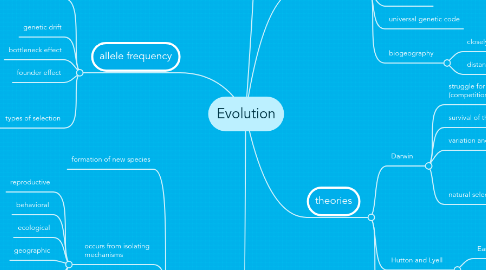
1. allele frequency
1.1. Hardy-Weinberg principle
1.1.1. genetic equilibrium is necessary
1.1.2. can predict which alleles are most frequent in a population
1.2. genetic drift
1.3. bottleneck effect
1.4. founder effect
1.5. types of selection
1.5.1. directional
1.5.2. stabilizing
1.5.3. disruptive
2. speciation
2.1. formation of new species
2.2. occurs from isolating mechanisms
2.2.1. reproductive
2.2.2. behavioral
2.2.3. ecological
2.2.4. geographic
2.2.5. temporal
2.2.6. mechanical
2.2.7. gametic
2.3. artificial selection
2.3.1. humans breed organisms with their desired traits until that trait becomes prevalent in the species
2.4. natural selection
2.4.1. survival of the fittest
2.4.2. (see "Darwin" branch for more info)
2.5. macroevolution
2.5.1. convergent evolution
2.5.2. divergent evolution
2.5.3. extinction
3. structure and function
3.1. homologous structures
3.1.1. same ancestry, different function
3.2. analogous structures
3.2.1. same function, different ancestry
3.3. vestigial structures
3.3.1. once used in ancestors but no longer used in current organism
4. evidence
4.1. fossil records
4.1.1. radioactive dating
4.1.1.1. carbon dating
4.1.2. relative dating
4.1.2.1. index fossils
4.2. anatomy (homologous structures)
4.3. physiology (analogous structures)
4.4. embyology
4.5. biochemistry
4.6. universal genetic code
4.7. biogeography
4.7.1. closely related but different
4.7.2. distantly related but similar
5. theories
5.1. Darwin
5.1.1. struggle for existence (competition)
5.1.2. survival of the fittest
5.1.3. variation and adaptation
5.1.4. natural selection
5.1.4.1. certain traits get passed on depending on which ones can survive nature
5.1.4.2. traits selected based on fitness
5.1.4.3. new traits occur from mutations
5.2. Hutton and Lyell
5.2.1. Earth is older than initially thought
5.2.2. examined geologic evidence
5.3. Lamarck
5.3.1. organisms pass on acquired traits
5.3.2. incorrect theory
